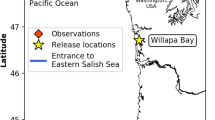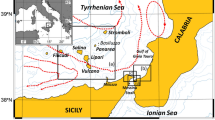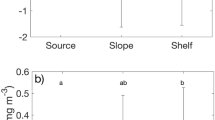Abstract
Antarctic krill (Euphausia superba) and crystal krill (Euphausia crystallorophias), important components of the Ross Sea food web, differ in their population distribution. The objective of this study was to determine whether these differing distributions result primarily from differences in spawning locations, larval development times, and transport by the Ross Sea circulation. To address this objective, Lagrangian particle tracking experiments were used to simulate the transport of larvae of Antarctic krill and crystal krill. The particle simulations showed that regions providing inputs of Antarctic krill to the Ross Sea were along the outer shelf/slope. Crystal krill transport and retention were along the shallow banks on the outer Ross Sea shelf. Particles initialized in the inner shelf off Victoria Land showed high retention in the region south and along the Terra Nova Bay polynya, with timescales consistent with development times of crystal krill. These results suggest that the cyclonic circulation over the shelf contributes significantly to the dispersion and retention of crystal krill in parts of the inner Ross Sea continental shelf that overlaps with regions with high concentrations of krill-dependent top predators. The westward circulation along the shelf break contributes to the transport and aggregation of Antarctic krill in regions where Circumpolar Deep Water is observed on the outer continental shelf and along the shelf break. The transport pathways and connectivity obtained from this study provide a baseline for assessing the effects of projected changes in the Ross Sea circulation on the distribution of two important krill species.





Similar content being viewed by others
References
Ainley DG, Jacobs SS (1981) Affinity of seabirds for ocean and ice boundaries in the Antarctic. Deep Sea Res 28A:1173–1185. doi:10.1016/0198-0149(81)90054-6
Ainley DG, Ballard G, Barton KJ, Karl BJ, Rau GH, Ribic CA, Wilson PR (2003) Spatial and temporal variation of diet within a presumed metapopulation of Adélie Penguins. Condor 105:95–106
Ainley DG, Ballard G, Dugger KM (2006) Competition among penguins and cetaceans reveals trophic cascades in the Ross Sea, Antarctica. Ecology 87:2080–2093
Ainley DG, Ballard G, Weller J (2010) Ross Sea bioregionalization, part I: validation of the 2007 CCAMLR bioregionalization workshop results towards including the Ross Sea in a representative network of marine protected areas in the Southern Ocean. CCAMLR WG-EMM-10/11, Hobart
Arrigo KR, Weiss AM, Smith WO Jr (1998) Physical forcing of phytoplankton dynamics in the southwestern Ross Sea. J Geophys Res 103:1007–1021
Azzali M, Kalinowski J (2000) Spatial and temporal distribution of krill E. superba biomass in the Ross Sea. In: Faranda FM, Guglielmo L, Ionora A (eds) Ross Sea ecology. Springer, Berlin, pp 433–455
Azzali M, Leonori I, De Felice A, Russo A (2006) Spatial–temporal relationships between two euphausiid species in the Ross Sea. Chem Ecol 22:219–233
Ballard G, Jongsomjit D, Veloz SD, Ainley DG (2012) Coexistence of mesopredators in an intact polar ocean ecosystem: the basis for defining a Ross Sea marine protected area. Biol Conserv 156:72–82
Bergamasco A, Defendi V, Budillon G, Spezie G (2004) Downslope flow observations near Cape Adare shelf-break. Antarct Sci 16(2):199–204
Brinton E, Townsend AW (1991) Development rates and habitat shifts in the Antarctic neritic euphausiid Euphausia crystallorophias, 1986–87. Deep Sea Res I 38:1195–1211
Ciappa A, Pietranera L, Budillon G (2012) Observations of the Terra Nova Bay (Antarctica) polynya by MODIS ice surface temperature imagery from 2005 to 2010. Remote Sens Environ 119:158–172
Cresswell KA, Tarling GA, Thorpe SE, Burrows MT, Wiedenmann J, Mangel M (2009) Diel vertical migration of Antarctic krill (Euphausia superba) is flexible during advection across the Scotia Sea. J Plankton Res 31:1265–1281
Daly KL (1990) Overwintering development, growth, and feeding of larval Euphausia superba in the Antarctic marginal ice zone. Limnol Oceanogr 35:1564–1576
Davey FJ (2004) Ross Sea bathymetry, 1:2,000,000, version 1.0, Institute of Geological and Nuclear Sciences Geophysical Map 16. Institute of Geological and Nuclear Sciences Limited, Lower Hutt
Demer DA, Hewitt RP (1995) Bias in acoustic biomass estimates of Euphausia superba due to diel vertical migration. Deep Sea Res I 42(451–461):463–475
Dinniman MS, Klinck JM, Smith WO Jr (2003) Cross-shelf exchange in a model of the Ross Sea circulation and biogeochemistry. Deep Sea Res II 50:3103–3120
Dinniman MS, Klinck JM, Smith WO Jr (2007) Influence of sea ice cover and icebergs on circulation and water mass formation in a numerical circulation model of the Ross Sea, Antarctica. J Geophys Res 112(C11013):1–13
Dinniman MS, Klinck JM, Smith WO (2011) A model study of circumpolar deep water on the west Antarctic Peninsula and Ross Sea continental shelves. Deep Sea Res II 58:1508–1523
Everson I (1982) Diurnal variations in mean volume backscattering strength of an Antarctic krill (Euphausia superba) patch. J Plankton Res 4:155–162
Fevolden SE (1980) Krill off Bouvetöya and in the southern Weddell Sea with a description of larval stages of Euphausia crystallorophias. Sarsia 65:149–162
Fraser FC (1936) On the development and distribution of the young stages of krill (Euphausia superba). Discov Rep 14:1–192
Gordon AL, Orsi AH, Muench R, Huber BA, Zambianchi E, Visbeck M (2009) Western Ross Sea continental slope gravity currents. Deep Sea Res II 56:796–817
Guglielmo L, Donato P, Zagami G, Granata A (2009) Spatio-temporal distribution and abundance of Euphausia crystallorophias in Terra Nova Bay (Ross Sea, Antarctica) during austral summer. Polar Biol 32:347–367
Harrington SA, Thomas PG (1987) Observations on spawning by Euphausia crystallorophias from waters adjacent to Enderby Land (East Antarctica) and speculations on the early ontogenetic ecology of neritic euphausiids. Polar Biol 7:93–95
Hofmann EE, Hüsrevoğlu YS (2003) A circumpolar modeling study of habitat control of Antarctic krill (Euphausia superba) reproductive success. Deep Sea Res II 50:3121–3142
Hofmann EE, Lascara CM (2000) Modeling the growth dynamics of Antarctic krill Euphausia superba. Mar Ecol Prog Ser 194:219–231
Hofmann EE, Capella JE, Ross RM, Quetin LB (1992) Models of the early life history of Euphausia superba—part I: time and temperature dependence during the descent–ascent cycle. Deep Sea Res 39:1177–1200
Hosie GW, Cochran TG, Pauly T, Beaumont KL, Wright SW, Kitchener JA (1997) Zooplankton community structure of Prydz Bay, Antarctica, January–February 1993. In: Proceedings of the National Institute of Polar Research (NIPR) symposium on polar biology, vol 10. pp 90–133
Hunter JR, Craig PD, Phillips HE (1993) On the use of random walk models with spatially variable diffusivity. J Comput Phys 106:366–376
Ichii T, Katayama K, Obitsu N, Ishii H, Naganobu M (1998) Occurrence of Antarctic krill (Euphausia superba) concentrations in the vicinity of the South Shetland Islands: relationship to environmental parameters. Deep Sea Res I 45:1235–1262
Ikeda T (1984) Development of the larvae of the Antarctic krill (Euphausia superba Dana) observed in the laboratory. J Exp Mar Biol Ecol 75:107–117
Ikeda T (1986) Preliminary observations on the development of the larvae of Euphausia crystallorophias Holt and Tattersall in the laboratory. Mem Natl Inst Polar Res Spec Issue 40:183–186
Kirkwood JM (1996) The developmental rate of Euphausia crystallorophias larvae in Ellis Fjord, Vestfold Hills, Antarctica. Polar Bio 16:527–530
Kohut J, Hunter E, Huber B (2013) Small-scale variability of the cross-shelf flow over the outer shelf of the Ross Sea. J Geophys Res 118:1863–1876. doi:10.1002/jgrc.20090
Kurtz DD, Bromwich DH (1983) Satellite observed behaviour of the Terra Nova Bay polynya. J Geophys Res 88:9717–9722
Lascara CM, Hofmann EE, Ross RR, Quetin LB (1999) Seasonal variability in the distribution of Antarctic krill, Euphausia superba, west of the Antarctic Peninsula. Deep Sea Res I 46:925–949
Locarnini RA (1994) Water masses and circulation in the Ross Gyre and environs. Ph.D. dissertation, p. 87. Texas A&M University, College Station, TX
Makarov RR, Menshenina LL, Timonin VP, Shurunov NA (1991) Ecology of larvae and reproduction of Euphausiidae in the Ross Sea. Biol Morya 3:156–162 (Translation from Russian. Original Article published 1988)
Marschall HP (1983) Sinking speed, density and size of euphausiid eggs. Meeresforschung 30:1–9
Murase H, Kitakado T, Hakamada T, Matsuoka K, Nishiwaki S, Naganobu M (2013) Spatial distribution of Antarctic minke whales (Balaenoptera bonaerensis) in relation to spatial distributions of krill in the Ross Sea, Antarctica. Fish Oceanogr 22:154–173
Nast F (1978) The vertical distribution of larval and adult krill (Euphausia superba Dana) on a time station of Elephant Island, South Shetlands. Meeresforschung 27:103–118
Orsi AH, Wiederwohl CL (2009) A recount of Ross Sea waters. Deep Sea Res II 56:778–795. doi:10.1016/j.dsr2.2008.10.033
Padman L, Howard SL, Orsi A, Muench R (2009) Tides of the northwestern Ross Sea and their impact on dense outflows of Antarctic Bottom Water. Deep Sea Res II 56:818–834. doi:10.1016/j.dsr2.2008.10.026
Pakhomov EA, Perissinotto R (1996) Antarctic neritic krill Euphausia crystallorophias: spatio-temporal distribution, growth and grazing rates. Deep Sea Res 43:59–87
Pakhomov EA, Perissinotto R (1997) Spawning success and grazing impact of Euphausia crystallorophias in the Antarctic shelf region. In: Battaglia B, Valencia J, Walton DWH (eds) Antarctic communities: species, structure and survival. Cambridge University Press, Cambridge, pp 187–192
Picco P, Bergamasco A, Demicheli L, Manzella G, Meloni R, Paschini E (2000) Large-scale circulation features in the Central and Western Ross Sea (Antarctica). In: Faranda F, Guglielmo L, Ianora A (eds) Ross sea ecology. Springer, Berlin, pp 93–105
Pillsbury RD, Jacobs SS (1985) Preliminary observations from long-term current meter moorings near the Ross Ice Shelf, Antarctica. Oceanology of the Antarctic Continental Shelf, Antarctic Research Series, vol 43. American Geophysical Union, Washington, DC, pp 87–107
Pinkerton MH, Bradford-Grieve J (2014) Characterizing food web structure to identify potential ecosystem effects of fishing in the Ross Sea. ICES J Mar Sci. doi:10.1093/icesjms/fst230
Pinkerton MH, Bradford-Grieve JM, Hanchet SM (2010) A balanced model of the food web of the Ross Sea, Antarctica. CCAMLR Sci 17:1–31
Piñones A, Hofmann EE, Dinniman MS, Klinck JM (2011) Lagrangian simulation of transport pathways and residence times along the western Antarctic Peninsula. Deep Sea Res II 58:1524–1539
Piñones A, Hofmann EE, Daly KL, Dinniman MS, Klinck JM (2013a) Modeling the remote and local connectivity of Antarctic krill populations along the western Antarctic Peninsula. Mar Ecol Prog Ser 481:69–92
Piñones A, Hofmann EE, Daly KL, Dinniman MS, Klinck JM (2013b) Modeling environmental controls on the transport and fate of early life stages of Antarctic krill (Euphausia superba) on the western Antarctic Peninsula continental shelf. Deep Sea Res I 82:17–31
Prézelin BB, Hofmann EE, Mengelt C, Klinck JM (2000) The linkage between upper circumpolar deep water (UCDW) and phytoplankton assemblages on the west Antarctic Peninsula continental shelf. J Mar Res 58:165–202
Quetin LB, Ross RM (1984) Depth distribution of developing Euphausia superba embryos, predicted from sinking rates. Mar Biol 79:47–53
Richerson K, Watters GM, Santora JA, Schroeder ID, Mangel M (2015) More than passive drifters: a stochastic dynamic model for the movement of Antarctic krill. Mar Ecol Prog Ser 529:35–48
Ross RM, Quetin LB (1986) How productive are Antarctic krill? Bioscience 36:264–269
Ross RM, Quetin LB, Kirsch E (1988) Effect of temperature on development times and survival of early larval stages of Euphausia superba Dana. J Exp Mar Biol Ecol 121:55–71
Rusciano E, Budillon G, Fusco G, Spezie G (2013) Evidence of atmosphere–sea ice–ocean coupling in the Terra Nova Bay polynya (Ross Sea-Antarctica). Cont Shelf Res 61–62:112–124
Sala A, Azzali M, Russo A (2002) Krill of the Ross Sea: distribution, abundance and demography of Euphausia superba and Euphausia crystallorophias during the Italian Antarctic Expedition (January–February 2000). Sci Mar 66:123–133
Smethie WM Jr, Jacobs SS (2005) Circulation and melting under the Ross Ice Shelf: estimates from evolving CFC, salinity and temperature fields in the Ross Sea. Deep Sea Res I 52:959–978
Smith WO Jr, Ainley DG, Cattaneo-Vietti R (2007) Trophic interactions within the Ross Sea continental shelf ecosystem. Philos Trans R Soc Lond B 362:95–111. doi:10.1098/rstb.2006.1956
Smith WO Jr, Sedwick PN, Arrigo KR, Ainley DG, Orsi AH (2010) The Ross Sea in a sea of change. Oceanography 25(3):90–103. doi:10.5670/oceanog.2012.80
Smith WO Jr, Dinniman MS, Hofmann EE, Klinck JM (2014) The effects of changing winds and temperatures on the oceanography of the Ross Sea in the 21st century. Geophys Res Lett 41:1624–1631. doi:10.1002/2014GL059311
Spiridonov VA (1995) Spatial and temporal variability in reproductive timing of Antarctic krill (Euphausia superba Dana). Polar Biol 15:161–174
Spiridonov VA (1996) A scenario of the Late-Pleistocene–Holocene changes in the distributional range of Antarctic krill (Euphausia superba). PSZN I: Mar Ecol 17:519–541
Stern AA, Dinniman MS, Zagorodnov V, Tyler SW, Holland DM (2013) Intrusion of warm surface water beneath the McMurdo Ice Shelf Antarctica. J Geophys Res 118:7036–7048. doi:10.1002/2013JC008842
Visser AW (1997) Using random walk models to simulate the vertical distribution of particles in a turbulent water column. Mar Ecol Prog Ser 158:275–281
Voronina NM (1995) Euphausiid larvae in the southern part of the Pacific sector of Antarctic in February to March, 1992. Oceanology 35(5):725–732 (English language edition 1996)
Whitworth III T, Orsi AH, Kim S-J, Nowlin Jr WD (1998) Water masses and mixing near the Antarctic slope front. In: Ocean, ice, and atmosphere: interactions at the Antarctic continental margin. Antarctic Research Series, vol 75. American Geophysical Union, Washington, DC, pp 1–27
Witek Z, Koronkiewicz A, Soszka GJ (1980) Certain aspects of the early life history of krill Euphausia superba Dana (Crustacea). Pol Polar Res 1:97–115
Zwally HJ, Comiso JC, Gordon AL (1985) Antarctic offshore leads and polynyas and oceanographic effects. In: Jacobs S (ed) Oceanology of the Antarctic Continental Shelf Antarct Res Ser, vol 43. AGU, Washington, DC, pp 203–226
Acknowledgments
This study was supported by the National Science Foundation Grant OCE-0622642 and by the National Science Foundation Office of Polar Programs Grants ANT-0838911 and ANT-0944174. A. Piñones is supported by the Yale Climate and Energy Institute (YCEI) at Yale University. A. Piñones also acknowledges FONDECYT/Chile 3150252. The suggestions and comments from three anonymous reviewers and the editor helped to improve and strengthen this manuscript.
Author information
Authors and Affiliations
Corresponding author
Additional information
This article is an invited contribution on Life in Antarctica: Boundaries and Gradients in a Changing Environment as the main theme of the XIth SCAR Biology Symposium. J.-M. Gili and R. Zapata Guardiola (Guest Editors).
Rights and permissions
About this article
Cite this article
Piñones, A., Hofmann, E.E., Dinniman, M.S. et al. Modeling the transport and fate of euphausiids in the Ross Sea. Polar Biol 39, 177–187 (2016). https://doi.org/10.1007/s00300-015-1798-5
Received:
Revised:
Accepted:
Published:
Issue Date:
DOI: https://doi.org/10.1007/s00300-015-1798-5




